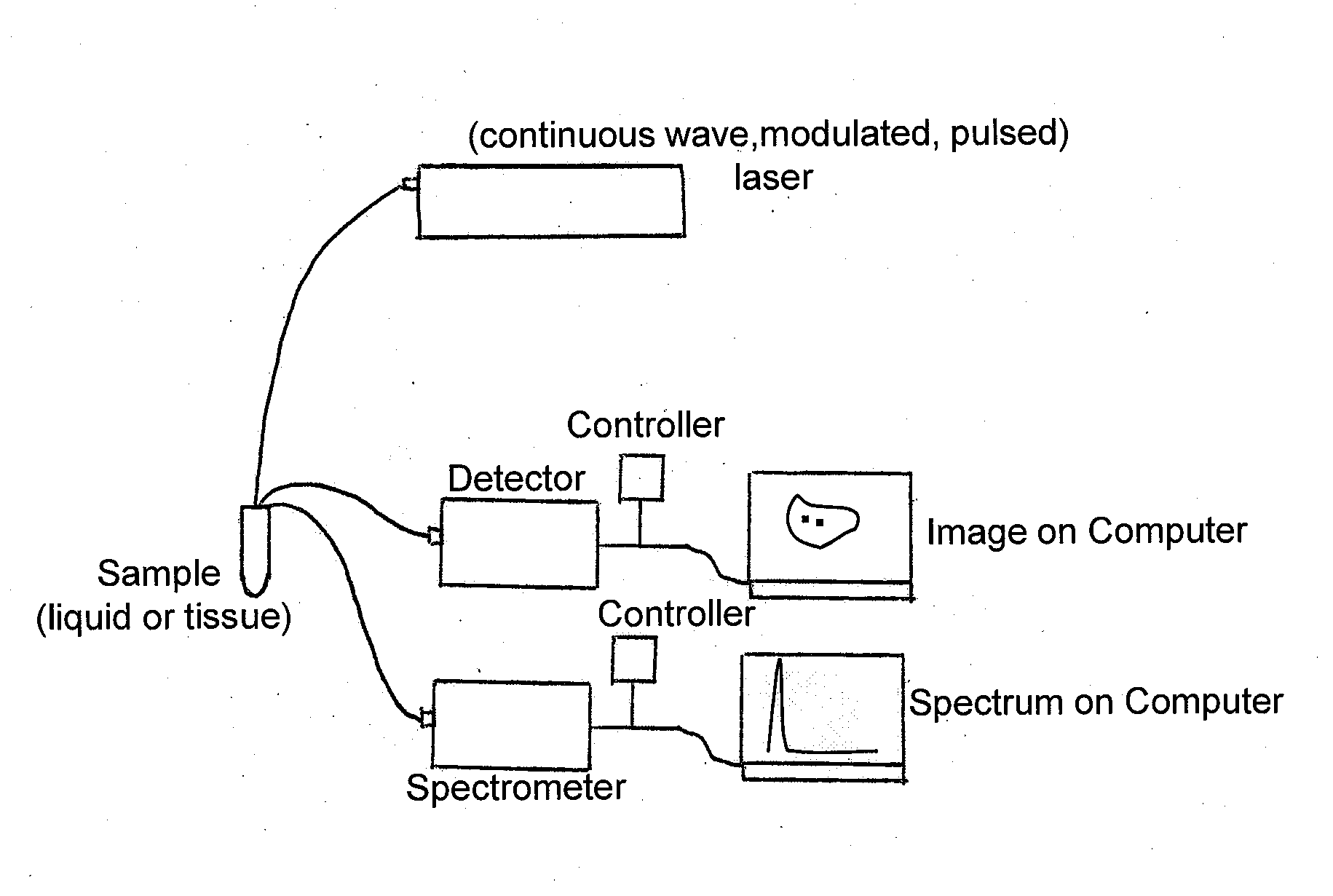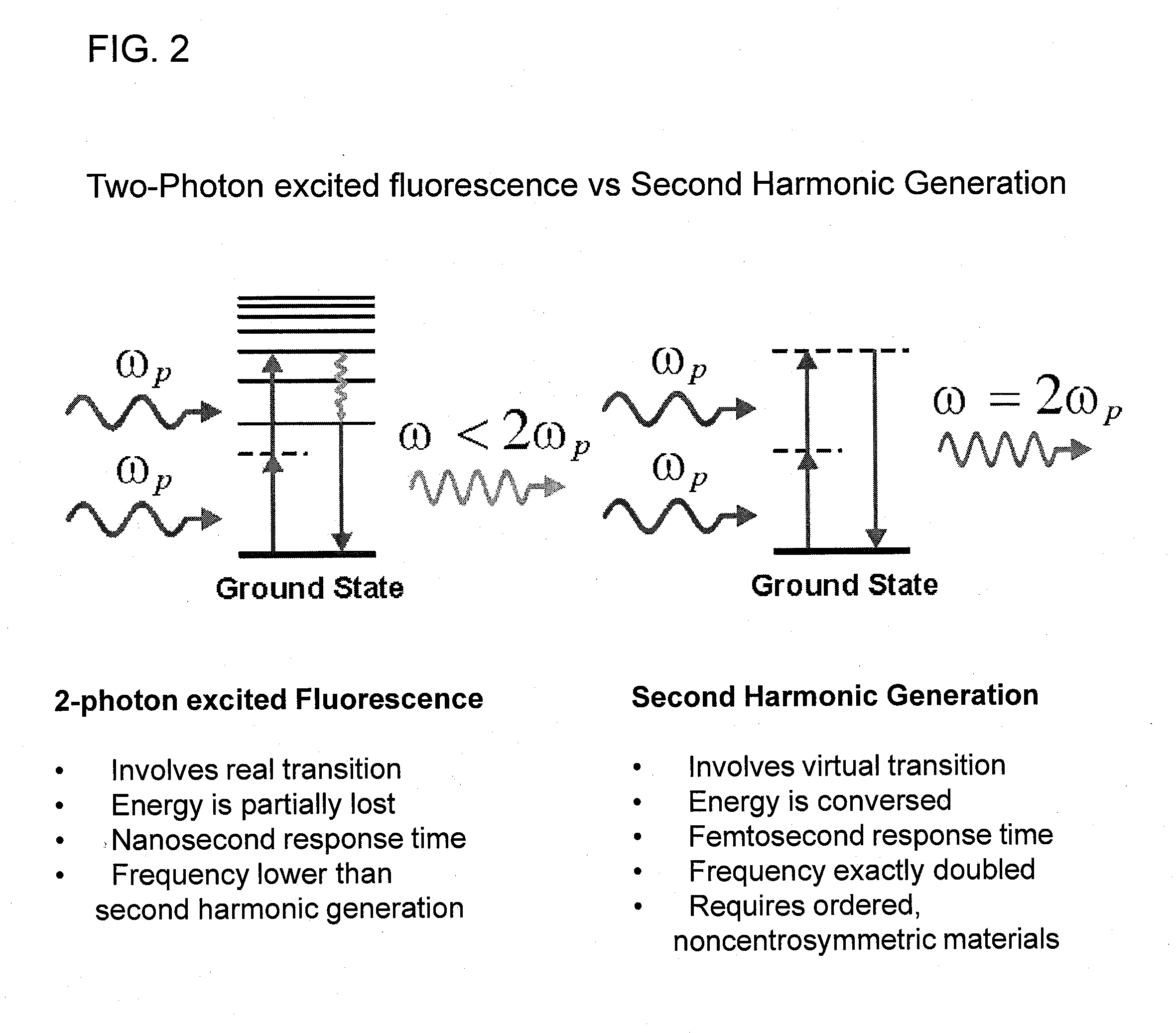Second harmonic imaging nanoprobes and techniques for use thereof
a nanoprobe and second harmonic technology, applied in the field of second harmonic imaging nanoprobes, can solve the problems of high cost, impede the widespread use of the technique, and the ultimate need of characterizing biological targets is largely unmet, so as to improve the electric field
- Summary
- Abstract
- Description
- Claims
- Application Information
AI Technical Summary
Benefits of technology
Problems solved by technology
Method used
Image
Examples
example 1
SH Nanoprobe Imaging
[0041]To demonstrate the superior imaging properties of the SHG nanocrystal probes of the current invention, BaTiO3 nanocrystals were injected into zebrafish embryos. Two days after cytoplasmic injection the nanocrystals were excited with femtosecond pulsed 820 nm light. As shown in the photographic plates provided in FIGS. 5A to 5D, the low energy excitation of the probe nanocrystals results in a strong second harmonic signal. (the bright point of light in the center of the image in FIG. 5A). This signal is detectable in epi-mode (FIG. 5A) as well as in trans-mode (FIG. 5B) throughout the whole zebrafish body (nanocrystal indicated at arrowhead in figures), proving the coherence of the technique. In contrast, the endogenous second harmonic signal from the tail-muscles can only be detected with relatively high energy excitation in the trans-mode (FIG. 5B). (For discussion, see, e.g., P. J. Campagnola, L. M. Loew, Nat Biotechnol 21, 1356 (November, 2003); and P. J...
example 2
Field Resonance Enhanced Second Harmonic Technique
[0043]In addition to simple second harmonic imaging using the second harmonic generating nanoprobes of the current invention, the nanoprobes may also be used in a field resonance enhanced mode to allow access to a number of biological processes that can occur below the nanosecond time frame. Using this field resonance enhanced second harmonic (FRESH) technique in accordance with the current invention it is possible to examine the dynamics of biological processes with high sensitivity and spatiotemporal resolution.
[0044]To understand the potential importance of the FRESH technique it is necessary to examine the inner workings of most biological processes. Besides having highly complex three-dimensional (3D) structures spanning a large range of length scales, living organisms by their nature are very dynamic: molecular processes such as protein, DNA, and RNA conformations—that take place in a timescale ranging from 100 fs to 100 s whil...
example 3
SH Nanoprobe Rapid Detection System
[0049]The present invention also relates to the use of SH nanoprobes in rapid detection systems, as shown in FIG. 8, that can be used by primary care level practitioners and field workers in hospitals or doctor's offices in the detection of disorders such as, for example, infectious disease or cancer from liquid or solid sources, among others. Because of the wide applicability of the SH nanoprobes of the current invention, SH nanoprobe detection mixtures can be designed for detection of a variety of conditions, and because of their high sensitivity such detection mixtures require only minimal amounts of SH nanoprobes for each analysis. Indeed, even the presence of a single sign of pathogenesis including, for example, an antigen, peptide sequence, nucleic acid sequence, RNA or DNA of an infectious pathogen could be detected using the rapid detection system of the current invention. As a result, these systems / kits will allow for the detection of a va...
PUM
| Property | Measurement | Unit |
|---|---|---|
| Length | aaaaa | aaaaa |
| Sensitivity | aaaaa | aaaaa |
| Frequency | aaaaa | aaaaa |
Abstract
Description
Claims
Application Information
 Login to View More
Login to View More - R&D
- Intellectual Property
- Life Sciences
- Materials
- Tech Scout
- Unparalleled Data Quality
- Higher Quality Content
- 60% Fewer Hallucinations
Browse by: Latest US Patents, China's latest patents, Technical Efficacy Thesaurus, Application Domain, Technology Topic, Popular Technical Reports.
© 2025 PatSnap. All rights reserved.Legal|Privacy policy|Modern Slavery Act Transparency Statement|Sitemap|About US| Contact US: help@patsnap.com



